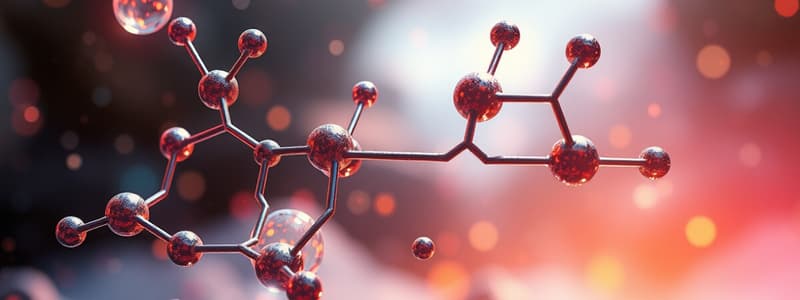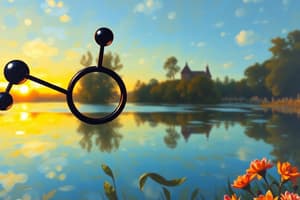Podcast
Questions and Answers
What term describes molecules that contain only carbon and hydrogen?
What term describes molecules that contain only carbon and hydrogen?
- Carbohydrates
- Lipids
- Polymers
- Hydrocarbons (correct)
Functional groups do not affect the chemical properties of organic molecules.
Functional groups do not affect the chemical properties of organic molecules.
False (B)
What are the four classes of biological monomers?
What are the four classes of biological monomers?
Carbohydrates, Lipids, Proteins, Nucleic acids
Organic molecules contain ______ carbon.
Organic molecules contain ______ carbon.
Match each type of biological monomer with its description:
Match each type of biological monomer with its description:
What is the simplest form of carbohydrates?
What is the simplest form of carbohydrates?
Steroid hormones are not modified structures based on cholesterol.
Steroid hormones are not modified structures based on cholesterol.
What process links monosaccharides into more complex carbohydrates?
What process links monosaccharides into more complex carbohydrates?
What type of bond is formed during dehydration synthesis of amino acids?
What type of bond is formed during dehydration synthesis of amino acids?
All proteins exhibit quaternary structure.
All proteins exhibit quaternary structure.
What is the primary structure of a protein determined by?
What is the primary structure of a protein determined by?
The water-insoluble proteins that form long parallel bundles are known as __________ proteins.
The water-insoluble proteins that form long parallel bundles are known as __________ proteins.
Match the following protein structures with their descriptions:
Match the following protein structures with their descriptions:
Which interactions are important for stabilizing the tertiary structure of a protein?
Which interactions are important for stabilizing the tertiary structure of a protein?
Denatured proteins are biologically active.
Denatured proteins are biologically active.
What type of proteins are antibodies and most enzymes categorized as?
What type of proteins are antibodies and most enzymes categorized as?
The formation of __________ bridges occurs between sulfhydryl groups in proteins.
The formation of __________ bridges occurs between sulfhydryl groups in proteins.
Which of the following is NOT a type of protein structure?
Which of the following is NOT a type of protein structure?
Which of the following accurately describes prothrombin?
Which of the following accurately describes prothrombin?
DNA contains uracil (U) in its structure.
DNA contains uracil (U) in its structure.
What are the three major types of RNA?
What are the three major types of RNA?
DNA undergoes __________ to create RNA.
DNA undergoes __________ to create RNA.
Match the following components of nucleic acids with their characteristics:
Match the following components of nucleic acids with their characteristics:
What is the backbone structure of nucleic acids made up of?
What is the backbone structure of nucleic acids made up of?
DNA is a single-stranded molecule.
DNA is a single-stranded molecule.
What happens during DNA replication?
What happens during DNA replication?
The monomers of nucleic acids are called __________.
The monomers of nucleic acids are called __________.
Who proposed the double helix structure of DNA?
Who proposed the double helix structure of DNA?
What is the primary biological role of adenosine triphosphate (ATP)?
What is the primary biological role of adenosine triphosphate (ATP)?
ATP is produced by endergonic reactions.
ATP is produced by endergonic reactions.
What happens to ATP during hydrolysis?
What happens to ATP during hydrolysis?
ATP is regenerated during aerobic cellular respiration by the enzyme ATP \\\______.
ATP is regenerated during aerobic cellular respiration by the enzyme ATP \\\______.
Match the following biological molecules with their characteristics:
Match the following biological molecules with their characteristics:
What is the proper name for the bond formed between monosaccharides during dehydration synthesis?
What is the proper name for the bond formed between monosaccharides during dehydration synthesis?
Disaccharides are formed by joining three monosaccharides.
Disaccharides are formed by joining three monosaccharides.
What is the primary storage polysaccharide in animals?
What is the primary storage polysaccharide in animals?
Starches are linear chains of __________ monomers.
Starches are linear chains of __________ monomers.
Match the type of fatty acid with its description:
Match the type of fatty acid with its description:
Which type of lipids represent about 18-25% of total body mass in humans?
Which type of lipids represent about 18-25% of total body mass in humans?
Humans possess the enzymes to break the bonds in cellulose.
Humans possess the enzymes to break the bonds in cellulose.
What type of molecule are triglycerides formed from?
What type of molecule are triglycerides formed from?
Fatty acids have a __________ group at one end of the hydrocarbon chain.
Fatty acids have a __________ group at one end of the hydrocarbon chain.
What is the general structure of triglycerides?
What is the general structure of triglycerides?
Flashcards are hidden until you start studying
Study Notes
Organic Molecules
- Contain carbon as a primary element; start with carbon skeletons connected by covalent bonds.
- Molecules comprising only carbon and hydrogen are classified as hydrocarbons.
- Functional groups, which are atoms or molecules attached to the carbon skeleton, alter the chemical properties and functions of organic molecules, such as steroid hormones derived from cholesterol.
Biological Molecules
- Composed of complex organic compounds; contain trillions of organic molecules in every cell, primarily in the form of polymers made from monomers.
- Four main types of biological monomers: carbohydrates, lipids, proteins, and nucleic acids.
Carbohydrates
- Composed of carbon, hydrogen, and oxygen, representing 2-3% of total body mass.
- Monosaccharides (simple sugars) are the monomers for carbohydrates.
- Joined through dehydration synthesis to form glycosidic linkages; include disaccharides (two monosaccharides) and polysaccharides (hundreds to thousands of monosaccharides).
- Examples include glycogen (animal storage) and starch (plant storage), distinguished by the stereochemistry of glycosidic bonds.
- Humans cannot digest cellulose due to the lack of specific enzymes.
Lipids
- Hydrophobic in nature, consisting mainly of carbon and hydrogen, constituting 18-25% of body mass.
- Types of lipids: fatty acids, triglycerides, phospholipids, steroids, eicosanoids, and fat-soluble vitamins.
- Saturated fatty acids have only single C-C bonds, whereas unsaturated fatty acids contain one or more C-C double bonds.
- Triglycerides consist of three fatty acids and glycerol; they can be solid (fats) or liquid (oils) at room temperature.
Proteins
- Formed by amino acids linked through peptide bonds via dehydration synthesis.
- Peptides are short chains of amino acids; polypeptides are long chains (10-2000 amino acids).
- Protein structure is classified into four levels:
- Primary: amino acid sequence based on gene sequence.
- Secondary: folding patterns like α-helices and β-sheets, stabilized by hydrogen bonds.
- Tertiary: three-dimensional shape influenced by primary/secondary structure, including disulfide bridges and hydrophobic interactions.
- Quaternary: arrangement of multiple polypeptide chains; not all proteins have this structure.
- Types include fibrous proteins (e.g., keratin) and globular proteins (e.g., antibodies and enzymes).
- Denaturation occurs when proteins lose structure, rendering them biologically inactive.
Nucleic Acids
- Made of carbon, hydrogen, oxygen, nitrogen, and phosphorus, existing as DNA or RNA.
- DNA is the hereditary material, made up of genes, and undergoes transcription to form RNA.
- Nucleotide monomers consist of a nitrogenous base, pentose sugar (deoxyribose in DNA, ribose in RNA), and a phosphate group.
- DNA bases include adenine, guanine, cytosine, and thymine; RNA contains adenine, guanine, cytosine, and uracil.
- DNA forms a double helix with base pairs (purine pairs with pyrimidine) contributing to its stability; RNA is typically single-stranded.
- ATP (adenosine triphosphate) serves as the energy currency in cells, synthesized through aerobic respiration, and releases energy via hydrolysis.
Summary
- Biological molecules encompass carbohydrates, lipids, proteins, and nucleic acids; all except lipids are polymers of monomers.
- Structure significantly influences the function of biological molecules.
Studying That Suits You
Use AI to generate personalized quizzes and flashcards to suit your learning preferences.




